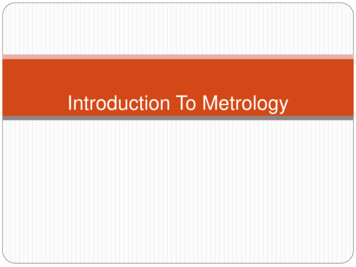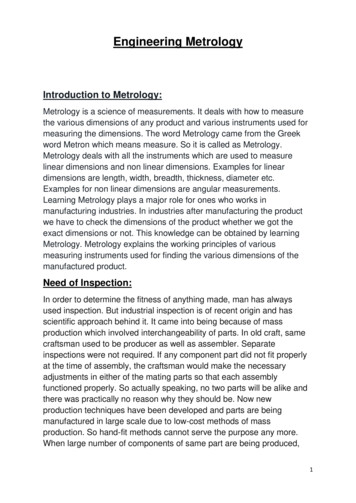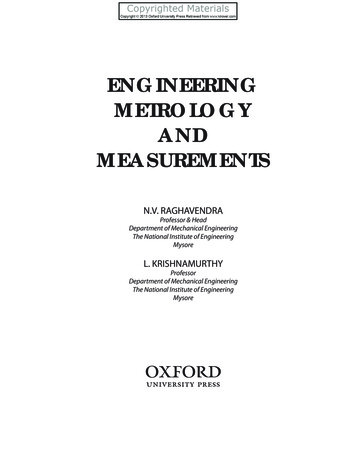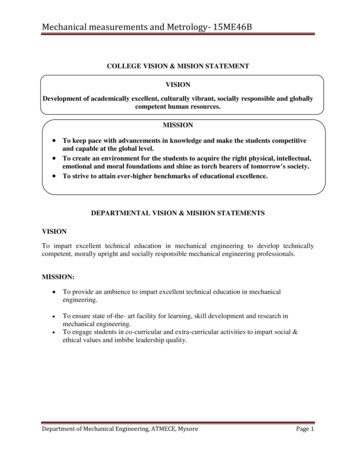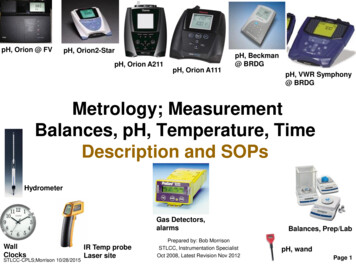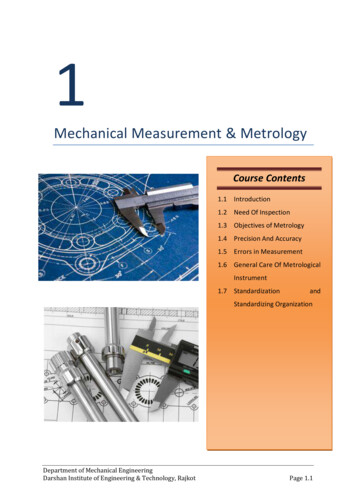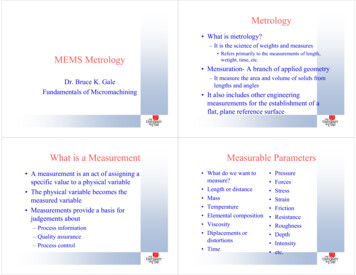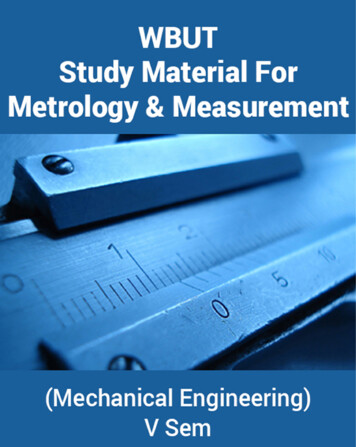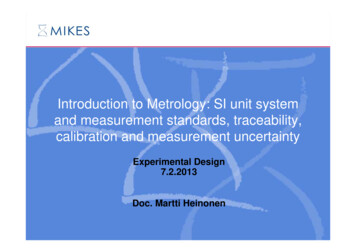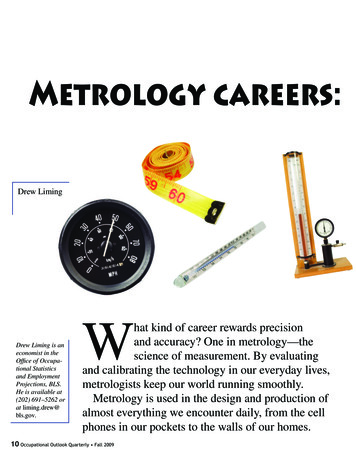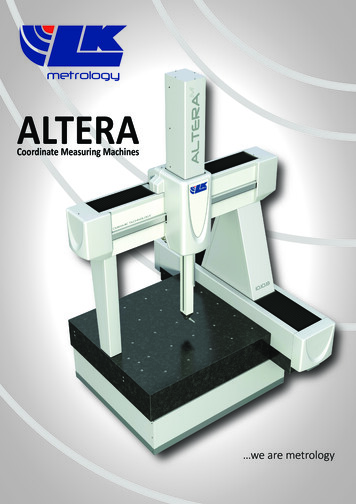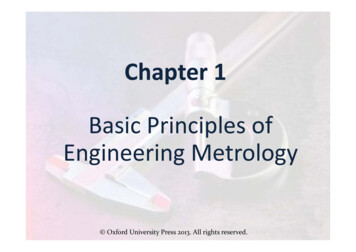
Transcription
Chapter 1Basic Principles ofEngineering Metrology Oxford University Press 2013. All rights reserved.
Introduction Measurement encompasses different fields such ascommunications, energy, medical sciences, food sciences,environment, trade, transportation, and military applications. Metrology concerns itself with the study of measurements. Measurement is an act of assigning an accurate and precisevalue to a physical variable. The physical variable then gets transformed into a measuredvariable. Meaningful measurements require common measurementstandards and must be performed using them. Oxford University Press 2013. All rights reserved.
Introduction The common methods of measurement are based on thedevelopment of international specification standards. Metrology is also concerned with the reproduction,conservation, and transfer of units of measurements and theirstandards. Measurements provide a basis for judgments about processinformation, quality assurance, and process control. Oxford University Press 2013. All rights reserved.
Importance Measurements provide a basis for judgments about processinformation, quality assurance, and process control. Design and proper operation and maintenance of such aproduct/system are two important aspects. Measurement is a significant source for acquiring veryimportant and necessary data about both these aspects ofengineering, without which the function or analysis cannot beperformed properly. Oxford University Press 2013. All rights reserved.
Importance Measurements are required for assessing the performance of aproduct/system, performing analysis to ascertain the responseto a specific input function, studying some fundamentalprinciple or law of nature, etc. Metrology helps extract high‐quality information regarding thecompletion of products, working condition, and status ofprocesses in an operational and industrial environment. Oxford University Press 2013. Allrights reserved.
Definition Metrology literally means science of measurements. In practical applications, it is the enforcement, verification andvalidation of predefined standards. Metrology is also concerned with the industrial inspection andits various techniques. Oxford University Press 2013. All rights reserved.
DefinitionMetrology also deals witha. Establishing the units of measurements and theirreproduction in the form of standards.b. Ascertaining the uniformity of measurements.c. Developing methods of measurement, analyzing theaccuracy of methods of measurement.d. Establishing uncertainty of measurement, and investigatingthe causes of measuring errors and subsequently eliminatingthem. Oxford University Press 2013. All rights reserved.
Legal Metrology Legal Metrology applies to any application of metrology that is subjected tonational laws or regulations. There will be mandatory and legal bindings on the units and methods ofmeasurements and measuring instruments. The scope of legal metrology may vary considerably from one country to another.The main objective is to maintain uniformity of measurement in a particularcountry. Legal metrology ensures the conservation of national standards and guaranteestheir accuracy in comparison with the international standards, thereby impartingproper accuracy to the secondary standards of the country. Applications of legal metrology are industrial measurement, commercialtransactions and public health and human safety aspects. Oxford University Press 2013. All rights reserved.
Inspection Inspection is defined as a procedure in which a part or productcharacteristic, such as a dimension, is examined to determinewhether it conforms to the design specification. Basically inspection is carried out to isolate and evaluate aspecific design or quality attribute of a component or product. In inspection, the part either passes or fails. Thus, industrialinspection has become a very important aspect of qualitycontrol. Oxford University Press 2013. All rights reserved.
InspectionInspection essentially encompasses the following:1. Ascertain that the part, material, or component conforms to theestablished or desired standard.2. Accomplish interchangeability of manufacture.3. Sustain customer goodwill by ensuring that no defective productreaches the customers.4. Provide the means of finding out inadequacies in manufacture.The results of inspection are recorded and reported to themanufacturing department for further action to ensureproduction of acceptable parts and reduction in scrap. Oxford University Press 2013. All rights reserved.
Inspection5. Purchase good‐quality raw materials, tools, and equipment thatgovern the quality of the finished products.6. Coordinate the functions of quality control, production,purchasing, and other departments of the organizations.7. Take the decision to perform rework on defective parts, that is,to assess the \ possibility of making some of these partsacceptable after minor repairs.8. Promote the spirit of competition, which leads to themanufacture of quality products in bulk by eliminatingbottlenecks and adopting better production techniques. Oxford University Press 2013. All rights reserved.
Accuracy Accuracy of measurement is very important for manufacturing aquality product. Accuracy is the degree of agreement of the measured dimensionwith its true magnitude. Accuracy can also be defined as the maximum amount by whichthe result differs from true value or as the nearness of themeasured values to its true value often expressed as a %. True value may be defined as the mean of the infinite number ofmeasured values when the average deviation due to the variouscontributing factors tends to zero. Oxford University Press 2013. All rights reserved.
Accuracy In practice, realization of the true value is not possible due touncertainties of the measuring process and hence cannot bedetermined experimentally. Positive and negative deviations from the true value are notequal and will not cancel each other. Oxford University Press 2013. All rights reserved.
Precision Precision is the degree of repetitiveness of the measuring process. It is the degree of agreement of the repeated measurements of aquantity made by using the same method, under similar conditions. Precision is the repeatability of the measuring process. The ability of the measuring instrument to repeat the same resultsduring the act of measurements for the same quantity is known asrepeatability. Repeatability is random in nature and, by itself, does not assureaccuracy, though it is a desirable characteristic. Oxford University Press 2013. All rights reserved.
Precision Precision refers to the consistent reproducibility of a measurement. Reproducibility is normally specified in terms of scale reading over a givenperiod of time. If an instrument is not precise it would give different results for the samedimension for the repeated readings.Difference between Precision & Accuracy Accuracy gives information regarding how far the measured value is withrespect to the true value, whereas precision indicates quality of measurement,without giving any assurance that the measurement is correct. These concepts are directly related to random and systematic measurementerrors. Oxford University Press 2013. All rights reserved.
Precision & AccuracyFigure 1 also depicts clearly the difference between the precision and accuracy.a) Precise but notnot Accurate(b) Accurate but notPrecise(c) Precise andAccurated) Not Precise andAccurateFigure 1.1: Accuracy and Precision. Oxford University Press 2013. All rights reserved.
Precision & Accuracy The difference between the true value and the mean valueof the set of readings on the same component is termed asan error. Error can also be defined as the difference between theindicated value and the true value of the quantity measured.E Vm Vtwhere E is the error, Vm the measured value, and Vt the truevalue. Oxford University Press 2013. All rights reserved.
Precision & AccuracyAccuracy of an instrument can also be expressed as % error.If an instrument measures Vm instead of Vt, then,% error x 100Or% error x 100 Oxford University Press 2013. All rights reserved.
Accuracy and Cost Oxford University Press 2013. All rights reserved.
Accuracy and CostGeneral Measurement ConceptsThe three basic elements of measurements1. Measurand, a physical quantity such as length, weight, and angle tobe measured.2. Comparator, to compare the measurand (physical quantity) with aknown standard (reference) for evaluation.3. Reference, the physical quantity or property to which quantitativecomparisons are to be made, which is internationally accepted Oxford University Press 2013. All rights reserved.
Calibration of Measuring Instruments The process of validation of the measurements to ascertain whetherthe given physical quantity conforms to the original/national standardof measurement is known as traceability of the standard. Calibration is the procedure used to establish a relationship betweenthe values of the quantities indicated by the measuring instrumentand the corresponding values realized by standards under specifiedconditions. It If the values of the variable involved remain constant (not timedependent) while calibrating a given instrument, this type ofcalibration is known as Static calibration, whereas if the value is time dependent or time‐based information isrequired, it is called Dynamic calibration. Oxford University Press 2013. All rights reserved.
Systematic or Controllable Errors A systematic error is a type of error that deviates by a fixed amount from the truevalue of measurement. These types of errors are controllable in both their magnitude and their direction. These types of errors can be assessed and minimized if efforts are made toanalyze them. The following are the reasons for their occurrence. Calibration errors Ambient conditions Deformation of work piece and Avoidable errors Oxford University Press 2013. All rights reserved.
Avoidable Errors Datum error Reading errors Misreading of the instrument Errors due to parallax effect Effect of misalignment Zero ErrorsRandom Errors Random errors provide a measure of random deviations whenmeasurements of a physical quantity are carried out repeatedly. When a series of repeated measurements are made on a componentunder similar conditions, the values or results of measurements vary. They are of variable magnitude and may be either positive or negative. Oxford University Press 2013. All rights reserved.
Sources of ErrorsThe following are the likely sources of random errors: Presence of transient fluctuations in friction in the measuringinstrument. Play in the linkages of the measuring instruments Error in operator’s judgment in reading the fractional part ofengraved scale divisions. Operator’s inability to note the readings because of fluctuationsduring measurement. Positional errors associated with the measured object and standard,arising due to small variations in setting. Oxford University Press 2013. All rights reserved.
Random ErrorsFigure 1.5 clearly depicts the relationship between systematic and random errorswith respect to the measured value. Oxford University Press 2013. All rights reserved.
Difference between Systematic andRandom Errors Oxford University Press 2013. All rights reserved.
Legal Metrology applies to any application of metrology that is subjected to national laws or regulations. There will be mandatory and legal bindings on the units and methods of measurements and measuring instruments. The scope of legal metrology
